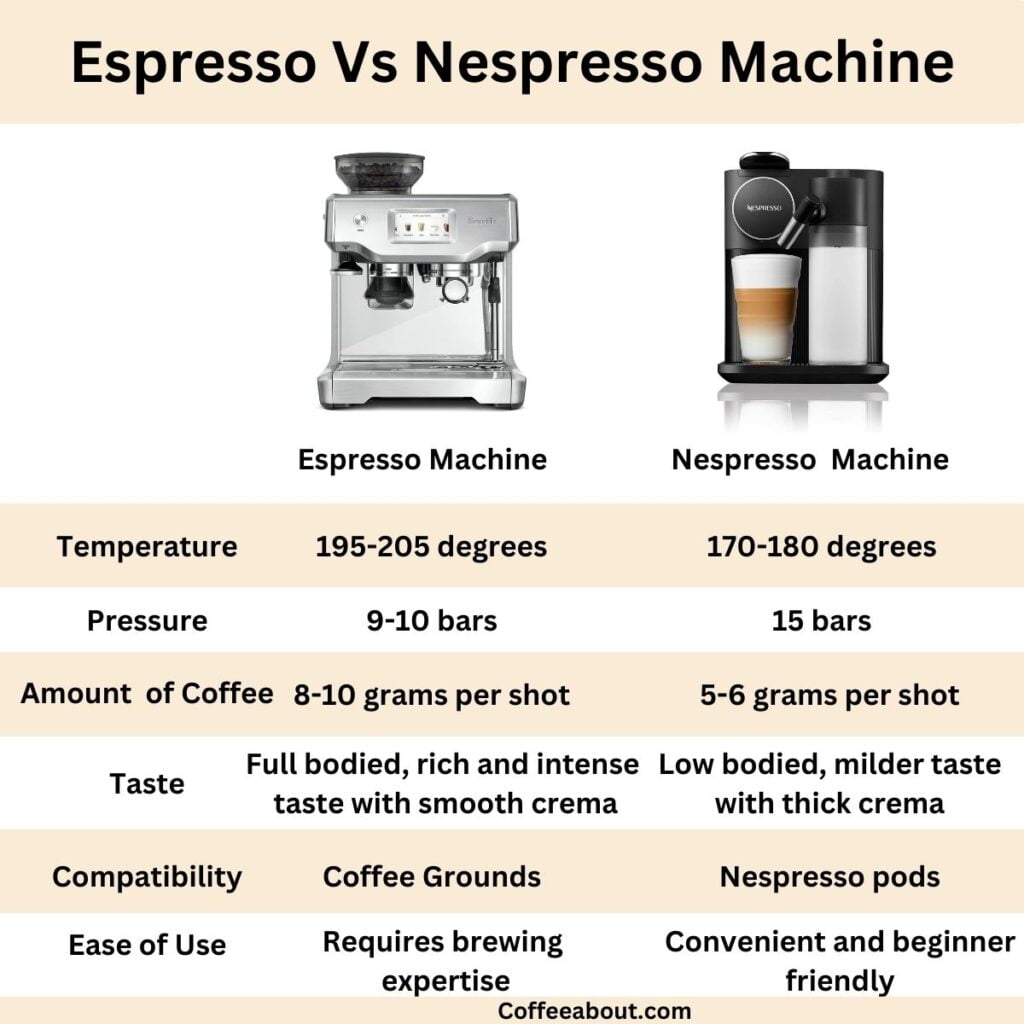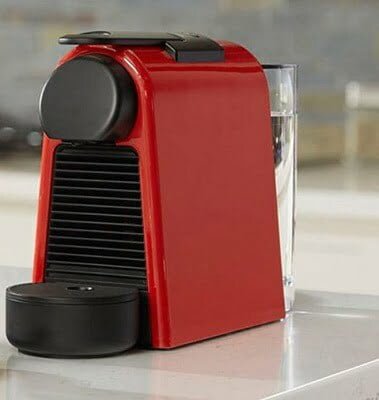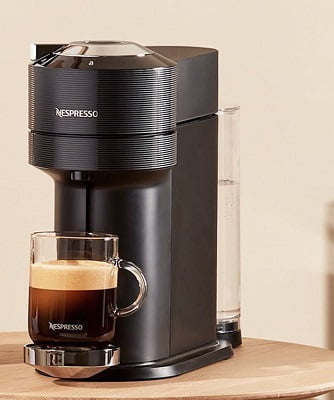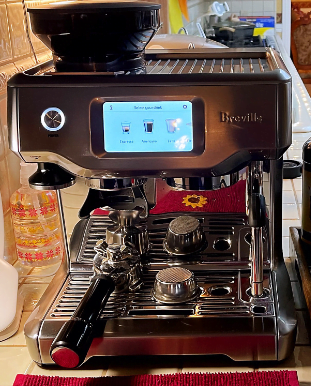Despite the convenience of Nespresso machines, many coffee enthusiasts argue that Nespresso coffee is not real espresso.
While Nespresso has certainly become a household favorite, its coffee does not measure up to the richness and robustness of authentic Italian espresso.
The main difference between the Nespresso and Espresso machines is that Nespresso uses pre-packaged Coffee capsules to simplify the brewing process while Espresso machines require users to grind coffee beans and manually operate the machine, providing more control over the brewing.

In this definitive guide, I’ll cut through the marketing hype and share a detailed, unbiased comparison of Nespresso vs Espresso machines. I’ll uncover the pros and cons of each, from drink options to convenience.
How does the Nespresso Machine work?
Nespresso is a single-serve Espresso machine that uses pre-packaged pods to brew concentrated shots of coffee.
The unique selling point of Nespresso machines is user-friendliness and convenience. Even a beginner can brew a shot of espresso without having to learn the complex brewing techniques.

While it is true that this machine cannot produce the best quality espresso drinks, its ability to brew shots in under a minute with the simple press of a button is what makes it so popular.
Nespresso coffee capsules contain 5-7 grams of ground coffee sealed in air-tight packaging to keep the coffee grounds fresh.
These capsules come in a diverse range of flavors and intensity levels, allowing you to customize your coffee drinks.
Nespresso offers two different line machines i.e. the Original line and the Vertuo line. Based on the working principle there are some differences among these lines.
Read a detailed comparison of Nespresso Original vs Vertuo Line
Original Line
Nespresso Original line machines operate similarly to traditional espresso machines by pumping the water at high pressure through coffee capsules.
The original line offers the flexibility to use both branded and third-party coffee capsules.
Inissia, Pixie, Essenza, Lattissima, and Creatista are the part of Original line Nespresso.

The Inissia, Pixie, and Essenza are entry-level machines that can only prepare a single or double shot of espresso.
While Lattissima and Creatista are high-end machines that can make milk-based espresso drinks that too at the touch of a button.
Vertuo Line
The Nespresso Vertuo line uses a centrifugation system instead of the traditional pumping system. In these machines, the capsule rotates at a rapid speed of 700 times per minute to produce a shot of espresso with a aerated and thick crema.

Vertuo Brewing System has a special barcode scanning technology that makes it compatible only with Branded Vertuoline capsules.
Vertuo line is not limited to Espresso shots only it also gives an option for brewing an 8 oz full cup of coffee (this option is not present in original line machines).
The Nespresso Vertuo line has three different models Plus, Evoluo, and the Next.
Also Read: Nespresso Vertuo Plus vs Vertuo Next
How does an Espresso Machine work?
Traditional Espresso machines have three different types i-e Manual, Semi-Automatic, and Fully Automatic.

Manual Espresso Machines
In manual espresso machines, you have to generate the pressure manually by applying physical force. These machines are not recommended unless you need them for portability, such as when traveling or camping.
Super Automatic Espresso Machines
Super-automatic Espresso machines are similar to Nespresso machines. You just have to push the button and the machine will take care of grinding, tamping, and pulling the shot.
These machines usually have built-in Grinders and Milk Frothers.
Compared to Nespresso machines, Super-automatic Espresso machines brew espresso using freshly ground coffee beans instead of capsules. And that’s a big plus point as it makes Espresso shot fresh and more flavorful.
Semi Automatic Espresso Machines
Semi-automatic espresso machines demand manual mastery of all brewing variables, such as coffee grounds dosage, grind size, portafilter tamping and distribution, and the final yield of the shot.
Espresso made with semi-automatic machines tastes the best when pulled by an expert Barista as it provides complete control over the process.
Read a guide on 15 different Espresso Machine types
Nespresso vs Espresso Machines (Showdown)
Let’s go through the different features of these machines and see how they compare.
1- Taste
Nespresso shots can never taste as good as a traditional espresso shot pulled by an expert barista. Espresso machines produce superior shots with a full body, rich and sweet flavor, and enticing aroma.
While Nespresso produces decent shots, they are milder in flavor and have a lighter body and airy crema layer than traditional espresso.
The difference in taste can be attributed to the difference in coffee to water ratio. Espresso machines usually use a ratio of coffee to water between 1:2, while Nespresso machines use a ratio of about 1:3 to 1:4.
Secondly, Espresso machines use fresh ground coffee beans to brew a shot, whereas Nespresso capsules are also fresh thanks to their specialized packaging, but they’re certainly not as fresh as freshly ground coffee beans.

Traditional espresso machines require expertise to brew a good shot of espresso, which can be challenging for beginners.
The best thing about the Nespresso machine is its consistency as it produces the same flavorful and decent shots every time.
2- Crema Layer
A thick caramel-colored layer present on the top of the Espresso shot is a trademark of Espresso. The texture and thickness of the crema layer say a lot about the quality of an Espresso shot.
In Nespresso machines, the crema layer is usually thicker and more aerated because of the high pressure of 15 bars, and it disappears very fast.
In traditional espresso machines, the crema layer has a dense and smooth texture that stays fresh for longer.
3- User-friendliness
Espresso machines can’t beat Nespresso in terms of convenience. It is undoubtedly the most significant plus point for Nespresso.
Brewing espresso with a standard espresso machine can be very difficult for beginners, requiring precise grinding, tamping, and distribution of the coffee grounds. And finally controlling the yield of the shot. Inexperienced users can mess up things at any point, resulting in a subpar shot of Espresso.
In contrast, Nespresso machines are incredibly easy to use. Simply insert a pod and press the brew button. The machine will take care of the rest, producing a consistent shot every time.
4- Time for brewing
Espresso machines take several minutes to preheat and pressurize, followed by the lengthy brewing process. On a standard espresso machine, brewing a shot takes around 5-7 minutes, and cleaning the machine afterward takes additional time.
On the other hand, the Nespresso machine heats up in 1 to 1:30 minutes, while a shot will take around 40 seconds to brew.
That’s just 2 minutes in total and you have to do nothing besides inserting the capsule and pressing the button.
5- Nespresso vs Espresso machine Cost
Nespresso machines are generally cheaper than good-quality standard Espresso machines. The starter Nespresso machine like Essenza mini costs around 150 dollars while High-end machines like Gran Lattissima can cost up to 600 dollars.
Semi-automatic Espresso machines are also not very expensive you can easily get them for around 200 or 300 dollars. And there are also some really good budget options like Delonghi ECP 3240.
The cost of a high-quality Super Automatic Espresso machine usually hovers around 1000 dollars. These machines have all the accessories and features you’ll need like a grinder, milk frother, and preset drink options.
Another point is that recurring costs with Nespresso machines are very high. Nespresso capsules cost are three times more expensive compared to ground coffee.
In fact, it’s the main business model of Nespresso, they actually earn more by selling coffee capsules than by selling coffee machines.
Read a detailed guide on Is Nespresso really worth it
Is Nespresso a Real Espresso?
The short answer to this question is it depends! There is no universal definition of Espresso. Many coffee organizations around the World define Espresso in their own way.
What Is Espresso?
According to Espresso Italiano, the definition of Espresso is:
The essential requirement is starting from a qualified blend that is processed by means of a qualified grinder dispenser and a qualified machine at the hands of a qualified operator, and complying with a few important parameters:
| Necessary portion of ground coffee | 7 g ± 0.5 |
| Exit temperature of water from the unit | 88°C ± 2°C |
| Temperature of the drink in the cup | 67°C ± 3°C |
| Entry water pressure | 9 bar ± 1 |
| Percolation time | 25 seconds ± 5 seconds |
| Viscosity at 45°C | > 1.5 mPa s |
| Total fat | > 2 mg/ml |
| Caffeine | < 100 mg/cup |
| Millilitres in the cup (including froth) | 25 ml ± 2.5 |
National Coffee Association published some facts about authentic Espresso:
1- Espresso is not a particular type of coffee bean or a particular roast, it is a drink
2- Espresso machines use 132 pounds per square inch of pressure to extract coffee.
3- One shot of espresso requires 50 coffee beans.
4- Brewed espresso has 2.5% fat, while filtered coffee contains 0.6% fat.
According to the Specialty Coffee Association:
“Espresso is a 25–35ml (.85–1.2 ounce [×2 for double]) beverage prepared from 7–9 grams (14–18 grams for a double) of coffee through which clean water of 195°–205°F (90.5°–96.1°C) has been forced at 9–10 atmospheres of pressure, and where the grind of the coffee is such that the brew time is 20–30 seconds. While brewing, the flow of espresso will appear to have the viscosity of warm honey and the resulting beverage will exhibit a thick, dark golden crema. Espresso should be prepared specifically for and immediately served to its intended consumer.”
So according to the above definitions, Nespresso machines clearly do not produce authentic Espresso mainly because of three facts
1- Amount of coffee beans: Nespresso uses 5-7 grams of coffee grounds for a shot of Espresso which is not enough for an authentic Espresso.
2- Brewing temperature: The brewing temperature inside the Nespresso machine is around 180 degrees for original line machines and 170 degrees for Vertuo line machines. That is less than 195-205 degrees required for authentic Espresso.
3- Pressure: Nespresso original line operates at the pressure of 15 bars which is more than 9-10 bars required for authentic Espresso. While Vertuo line machines have a completely different centrifugation technology.
Also read: 9 vs 15 bars Espresso
Many respected coffee associations around the World have their own definition of Espresso. But does the definition really matter?
For me, what matters is whether Nespresso produces good coffee, and regardless of whether it qualifies as espresso or not, I think the flavor of coffee from Nespresso is quite good.
And the most important thing is flavors are consistent with every capsule.
Nespresso vs Espresso Machine
Which you should buy?
Both Nespresso and Espresso machines have their pros and cons as discussed in the article. In the end, I wanna summarize the article with What machine is best for you!
If you are passionate about Espresso and you can’t compromise on the taste and quality of your brew, and you are willing to spend time learning the brewing skill then you should definitely go with a standard Espresso machine.
However, if you are really busy, you don’t have a lot of time in the mornings for brewing coffee, and convenience matters a lot for you then you should go with a Nespresso machine.
Also Check out:
- Nespresso Delonghi vs Breville
- Lavazza vs Nespresso
- Nespresso vs Keurig Coffee Maker
- Nespresso vs Ninja coffee bar
- Nespresso Vertuo vs Original
Does Nespresso make espresso shots or coffee?
Nespresso Vertuo line Models offer both Espresso shots and regular 8 oz serving of coffee while the original line models are only limited to only Espresso and lungo shots.
Are Nespresso Pods Recyclable?
Yes, Nespresso Pods are made of Aluminum and completely recyclable. In fact, Nespresso has its own dedicated recycling program.



